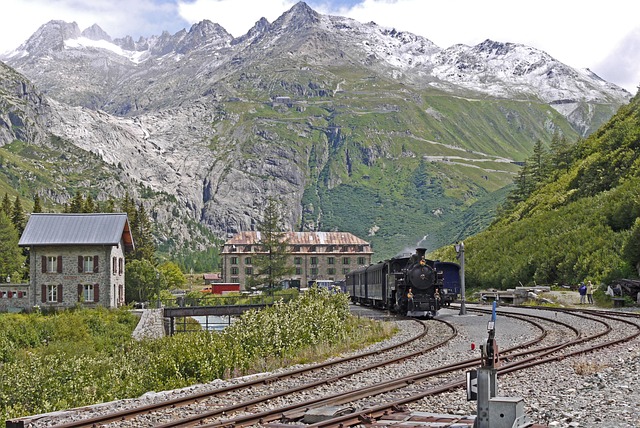From Alps to Coast: 13 Iconic European Train Routes to Experience
Embark on a journey through Europe's breathtaking landscapes with our guide to 13 iconic train routes. From the majestic Alps to the picturesque coastlines, experience the beauty and charm of Europe like never before. Discover the history, culture, and allure of each destination as you travel through some of the most scenic routes on the continent.

Which train routes offer the best Alpine experiences?
The Alps, Europe’s majestic mountain range, provide some of the most breathtaking scenery for train travelers. Here are three iconic routes that traverse this stunning landscape:
-
Glacier Express (Switzerland): Often called the slowest express train in the world, this 8-hour journey connects Zermatt and St. Moritz. Passengers can marvel at the Swiss Alps’ pristine beauty, crossing 291 bridges and passing through 91 tunnels.
-
Bernina Express (Switzerland/Italy): This route takes you from Chur or St. Moritz in Switzerland to Tirano in Italy. The train climbs to altitudes over 2,000 meters, offering spectacular views of glaciers, lakes, and the Bernina Pass.
-
Arlberg Pass (Austria): Connecting Innsbruck to Bludenz, this route showcases the stunning Austrian Alps, winding through picturesque valleys and charming mountain villages.
What are the most scenic coastal train journeys in Europe?
For those who prefer seaside vistas, Europe’s coastlines offer equally impressive train routes:
-
Cinque Terre (Italy): This short but spectacular journey along the Italian Riviera connects the five colorful villages of Cinque Terre, offering stunning views of the Mediterranean Sea.
-
Bergen Line (Norway): While not entirely coastal, this route from Oslo to Bergen culminates in breathtaking fjord views as it approaches the western coast of Norway.
-
West Highland Line (Scotland): Running from Glasgow to Mallaig, this route is famous for its coastal and mountain scenery, including the Glenfinnan Viaduct featured in Harry Potter films.
Which train routes showcase Europe’s diverse landscapes?
Some European train routes offer a perfect blend of various landscapes:
-
Flåm Railway (Norway): This 20-kilometer journey from Myrdal to Flåm descends 866 meters, passing through mountains, forests, and fjords.
-
Semmering Railway (Austria): A UNESCO World Heritage site, this route connects Vienna to Graz, showcasing the transition from Alpine landscapes to gentler hills.
-
Madrid to Oviedo (Spain): This journey takes you from Spain’s central plains through the Cantabrian Mountains to the lush green landscapes of Asturias.
What are the most historically significant train routes in Europe?
Several European train routes are steeped in history and cultural significance:
-
Orient Express (Various routes): While the original luxury train no longer operates, various companies offer similar experiences inspired by this iconic route connecting Paris to Istanbul.
-
Transfăgărășan Railway (Romania): Built as a strategic military route, this scenic journey crosses the Carpathian Mountains, offering stunning views and a glimpse into Romania’s history.
-
Berlin to Prague: This route connects two historically rich cities, passing through the beautiful Saxon Switzerland National Park.
How can travelers maximize their European train experience?
To make the most of your European train journey:
-
Consider purchasing a Eurail Pass for flexibility and potential cost savings if visiting multiple countries.
-
Book panoramic or observation cars when available for the best views.
-
Travel during shoulder seasons (spring or fall) to avoid crowds and enjoy milder weather.
-
Pack light, as storage space can be limited on some trains.
-
Bring a camera or binoculars to capture and appreciate the scenery fully.
What are some practical tips for planning a European train adventure?
Planning a train journey through Europe requires some preparation:
-
Research and book tickets in advance, especially for popular routes during peak seasons.
-
Check if seat reservations are required or recommended for your chosen routes.
-
Be aware of border crossings and any necessary documentation.
-
Download offline maps and train timetables for areas with limited internet connectivity.
-
Consider breaking up longer journeys with overnight stays in interesting locations along the route.
| Route Name | Countries | Key Features | Approximate Duration |
|---|---|---|---|
| Glacier Express | Switzerland | Alpine scenery, luxury panoramic cars | 8 hours |
| Bernina Express | Switzerland, Italy | UNESCO World Heritage site, high-altitude views | 4 hours |
| Flåm Railway | Norway | Steep gradients, fjord views | 1 hour |
| Cinque Terre | Italy | Coastal views, connects five villages | 30 minutes (between villages) |
| West Highland Line | Scotland | Coastal and mountain scenery, Glenfinnan Viaduct | 5 hours 30 minutes |
Prices, rates, or cost estimates mentioned in this article are based on the latest available information but may change over time. Independent research is advised before making financial decisions.
In conclusion, European train routes offer an unparalleled way to experience the continent’s diverse landscapes, from the towering Alps to picturesque coastlines. Whether you’re seeking breathtaking natural beauty, historical significance, or a blend of cultures, these 13 iconic routes provide unforgettable journeys that showcase the best of Europe’s scenic wonders. By choosing rail travel, you not only gain a unique perspective on these destinations but also contribute to a more sustainable and immersive form of tourism.




